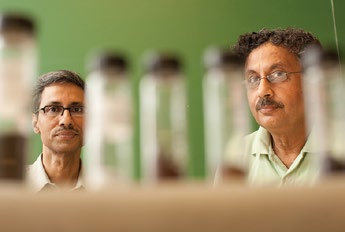A new technique that uses pH to sense toxic metals in water could lead to the development of an inexpensive, easy-to-use device that monitors water quality. Such a device could help detect contamination in water bodies, enable households to test drinking water, and prove invaluable in countries with limited access to conventional water-testing techniques.
The simple test, says Arup SenGupta, the P.C. Rossin Professor of civil and environmental engineering, involves passing water through a mini-column of granular sorbent material and then testing its pH. The sorbent is a fused mixture of hydrated ferric oxide and akermanite (calcium magnesium silicate). When uncontaminated water passes through the column, it becomes alkaline due to the slow hydrolysis of the akermanite and the steady release of hydroxyl ions.
When a drop of phenolphthalein indicator is added to water exiting the column it turns pink. Trace concentrations of a heavy metal such as lead or zinc, however, cause the exit water to turn acidic and remain colorless when phenolphthalein is added.
“At first, the granular material in the column absorbs the heavy metal ions,” says SenGupta. “After a while, all the absorption sites become occupied and the remaining metal ions pass through the column. These ions then form metal-hydroxyl complexes by reacting with the hydroxyl ions in the exit water. Reducing the number of hydroxyl ions in the exit water changes its pH from alkaline to neutral — a neutral solution remains colorless when a drop of phenolphthalein indicator is added.”
SenGupta came up with the idea for the test several years ago while working on a project using much larger quantities of a similar fused mixture to clean up a water supply. With the help of his graduate student, Prasun Chatterjee, he was able to develop it.
According to EPA’s drinking water regulations, allowable levels for copper and zinc are 1.3 and 5 milligrams per liter of water. For lead, the acceptable level is 15 micrograms — about a hundred times lower.
“Because the target level for detecting lead is so low,” says Chatterjee, “we had to use a simple preconcentration step.”
Another hurdle encountered was the possible interference of phosphates and natural organic matter often present in water bodies. This was overcome by placing a small amount of one of SenGupta’s patented hybrid anion exchange materials, comprised of iron oxide nanoparticles dispersed inside polymer beads, above the fused sorbent mixture in the column. This first layer of material removes phosphates and other weakacid anions from the water before it passes through the fused mixture of hydrated ferric oxide and akermanite.
“So far, the test has proved very successful for deliberately spiked samples of Lehigh River water,” says SenGupta. “Unfortunately, with our current device, a liter of water is needed to observe the required pH change.” The team is modifying the sorbent material to work with smaller volumes of water.
For their recent paper published in the AlChE Journal, Chatterjee will receive the prestigious 2010 C. Ellen Gonter Environmental Chemistry Award from the American Chemical Society. This is one of the highest honors bestowed on a graduate student working in environmental chemistry.

